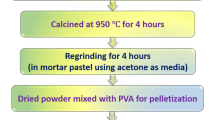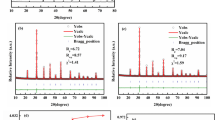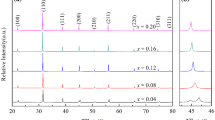Abstract
In order to develop dielectric ceramics with temperature-stable permittivity characteristics, perovskite BaTiO3–Bi(Zn1/2Ti1/2)O3–NaNbO3 ceramic solid solutions were investigated with a particular focus on effects of BaTiO3 and NaNbO3 contents on the dielectric properties of ternary compounds. Keeping the ratios of the other two constituents constant, decreasing the BaTiO3 content leads to a broadening of the temperature-dependent permittivity maximum and a decrease in the overall permittivity. For compositions of constant BaTiO3 content, replacing Bi(Zn1/2Ti1/2)O3 with NaNbO3 shifts the temperature of the maximum permittivity to lower temperatures (e.g., to −103 °C for a composition of 70BT–5BZT–25NN) while maintaining a broad permittivity peak with temperature, which for the 50BT–25BZT–25NN composition also satisfies the X9R standard. Thus, the investigation of BT–BZT–NN compounds resulted in promising dielectric properties with broad temperature ranges of high permittivity, which is of interest for advanced capacitor applications.
Similar content being viewed by others
Explore related subjects
Discover the latest articles, news and stories from top researchers in related subjects.Avoid common mistakes on your manuscript.
Introduction
Perovskite materials are known to be of interest for a wide variety of electroceramic applications. Various groups of materials have recently been investigated including lead-based [1–3], non-lead-based [4], and bismuth-based perovskite [5]. In capacitor technologies, high temperature-stable permittivity, low dielectric loss, and high insulation resistance are desirable. Solid solutions of BaTiO3–BiMO3 and PbTiO3–BiMO3, in which the BiMO3 compounds are known to be unstable in the perovskite structure under ambient conditions, have recently received a great deal of interest because of their attractive dielectric and piezoelectric properties, where M represents Zn1/2Ti1/2 [6, 7], Mg1/2Ti1/2 [8–11], Ni1/2Ti1/2 [12, 13], and Sc [11, 14]. Of particular interest to this study, it has been shown that BiMO3 additions transform the characteristic sharp phase transition—and associated permittivity maximum—of pure BaTiO3 into a less-distinct phase transition with a broad and strongly dispersive permittivity maximum characteristic of relaxor dielectrics. In addition, the temperature of maximum permittivity (T max) decreased significantly (to below room temperature) with low concentrations of BiMO3 and then increased, to higher than room temperature, as the BiMO3 content increased [6, 8, 9, 12, 14]. This phenomenon has been observed both in the pseudo-binary systems mentioned earlier as well as in pseudo-ternary systems such as BaTiO3–Bi(Zn1/2Ti1/2)O3–BiInO3 [15] and BaTiO3–Bi(Zn1/2Ti1/2)O3–BiScO3 (BT–BZT–BS) [16, 17]. The latter compound, BT–BZT–BS, showed excellent dielectric and electrical properties for high-temperature capacitor applications exhibiting a flat temperature dependent of relative permittivity over a broad temperature range. However, the large temperature and frequency dependence of permittivity at temperatures below ~100 ºC are undesirable for the use of these materials in applications requiring ambient operation.
In order to decrease T max to temperatures well below room temperature and to improve the temperature stability of the relative permittivity of BaTiO3–Bi(Zn1/2Ti1/2)O3-based ceramics, sodium niobate (NaNbO3) was selected as an end-member for the ternary system. NaNbO3 has the perovskite structure and exhibits both orthorhombic symmetry and antiferroelectricity at room temperature [18]. Complex phase transitions driven by temperature were also seen in this material [19]. It has also been known as the host materials for developing high-performance lead-free piezoelectric (K1/2Na1/2)NbO3 [20, 21].
NaNbO3 has been shown to form a complete substitutional solid solution with BaTiO3 [22]. While the end members of this BaTiO3–NaNbO3 solid solution have Curie temperatures (and associated permittivity maxima) at 126 and 347 ºC, respectively, compositions containing 20–30 mol% NaNbO3 have been shown to have T max values below −73 ºC [22]. In addition, a single-phase perovskite could be formed in NaNbO3–Bi(Zn1/2Ti1/2)O3 solid solutions when the concentration of Bi(Zn1/2Ti1/2)O3 is no more than 10 mol% [23]. Low additions of Bi(Zn1/2Ti1/2)O3 (BZT) also transformed the antiferroelectric behavior of pure NaNbO3 (NN) to relaxor ferroelectric behavior. It should be also noted that the multiple phase transitions found in pure NaNbO3 transformed to a diffuse phase transition for NN–BZT compositions close to the solubility limit. Importantly, compositions containing between 7 and 10 mol% BZT exhibited T max values below −50 ºC.
Thus, in order to develop dielectric material with a low transition temperature (T max), the BaTiO3–Bi(Zn1/2Ti1/2)O3–NaNbO3 solid solutions were investigated. Two groups of compositions were studied (Fig. 1) as follows;
-
1)
xBaTiO3–(100 − x)(0.5Bi(Zn1/2Ti1/2)O3–0.5NaNbO3), where x = 50–80.
-
2)
70BaTiO3–(30 − y)Bi(Zn1/2Ti1/2)O3–yNaNbO3, where y = 5–25.
The dielectric properties and polarization hysteresis behaviors of these solid solutions are demonstrated here.
Experimental procedure
A solid-state reaction method was used to prepare the BaTiO3–Bi(Zn1/2Ti1/2)O3–NaNbO3 solid solutions from BaCO3 (99.8 %), Bi2O3 (99.9 %), Na2CO3 (99.5 %), ZnO (99.9 %), Nb2O5 (99.9 %), and TiO2 (99.0 %) precursors. Aqueous mixtures of batched powders were mixed and ground using a vibratory milling machine for 6 h and then dried at 100 ºC overnight. A calcination process was carried out at 900–1000 ºC for 4 h in covered alumina crucibles. The calcined powders were ground again before pressing into disk shape by uniaxial pressing. Green pellets were sintered on top of powders of the same composition in covered alumina crucibles in static air at 1120–1220 ºC for 4 h in a box furnace with ramp rates of ±3 °C/min. Formation of a single perovskite phase was confirmed using a laboratory X-ray diffractometer (Bruker AXS D8 Discover, Cu Kα). The surfaces of the resulting dense ceramics were polished before applying silver electrodes which were fired on at 700 °C for 10 min. The sample dimensions for electrical measurements were ~0.80 mm in thickness and ~10.60 mm in diameter. The temperature dependence of dielectric properties was measured on cooling from 200 to −150 ºC using an Agilent 4284A LCR meter and a custom sample holder. Polarization-field behavior was investigated at room temperature using a Precision Premier II ferroelectric test system (Radiant Technologies).
Results and discussion
The results presented in this section are divided into two groups according to the composition series previously mentioned. The ternary diagram shown in Fig. 1 identifies the specific composition in this study.
Group 1 consists of xBaTiO3–(100 − x)(0.5Bi(Zn1/2Ti1/2)O3–0.5NaNbO3), where x = 50–80; in other words, the ratio of Bi(Zn1/2Ti1/2)3:NaNbO3 was fixed at 1:1, while the BaTiO3 content was varied from 50 to 80 mol%. X-ray diffraction patterns from the group 1 compositions are shown in Fig. 2. All compositions were observed to exhibit a single perovskite phase. Careful investigation of the diffraction peaks showed no evidence of distortions or asymmetry, which suggests the existence of cubic symmetry. Lattice parameters were calculated by Cohen’s method and showed an increasing trend with BaTiO3 content. However, at x = 60 and 70, the lattice parameter remained nearly constant.
Figure 3a shows temperature-dependent dielectric data measured at 1 and 10 kHz. A strong frequency dependence of relative permittivity is clearly seen at temperatures below T max for all compositions, but dispersion above T max is negligible. This behavior is consistent with the relaxor-like behavior observed in similar systems [6, 14, 15]. Interestingly, as shown in Fig. 3b, while the maximum relative permittivity (ε r, max) decreased monotonically with decreasing BaTiO3 content between x = 80 mol% and x = 50 mol%, T max initially decreased from −6 to −40 ºC as the BaTiO3 content decreased from 80 to 70 mol% but remained nearly unchanged for BaTiO3 values from 50 to 70 mol%. It should be mentioned that tan δ at 1 kHz remained below 0.05 over a wide temperature range from approximately −70 to 350 ºC. Over the temperature range of 0 –200 ºC, where the relative permittivity is not frequency dispersive, a decreased BaTiO3 content improved the temperature stability of relative permittivity. The temperature coefficients of permittivity (TCε) varied from −1960 ppm/K for the 80:10:10 composition to −790 ppm/K for the 50:25:25 composition.
Polarization hysteresis measurements collected at room temperature show slim hysteresis loops with negligible remanent polarization for all compositions (Fig. 4). While the 80BT–10BZT–10NN composition showed pseudo-linear dielectric response with slight saturation at high fields, all other compositions remained linear across the measured fields. The maximum polarization (P max) exhibited a decreasing trend as the BaTiO3 content decreased, similar to the relative permittivity values.
The results shown in this section demonstrate the role of BaTiO3 content on dielectric properties of the BaTiO3–Bi(Zn1/2Ti1/2)O3–NaNbO3 ternary system. The compositions containing 50, 60, and 70 % of BaTiO3 exhibited similar dielectric characteristics in which higher relative permittivity for the 70BT–15BZT–15NN composition was observed as compared to that of the 60BT–20BZT–20NN and the 50BT–25BZT–25NN compositions. Therefore, the composition containing 70 % of BaTiO3 was selected to further examine the role of NaNbO3 in this ternary system.
Group 2 compositions consist of 70BaTiO3–(30 − y)Bi(Zn1/2Ti1/2)O3–yNaNbO3 where y = 5–25; in other words, the BaTiO3 content was kept constant while the BZT:NN ratio was varied (Fig. 1). As shown in Fig. 5, diffraction patterns from all compositions were consistent with a single cubic perovskite phase. A decrease in lattice parameter was observed as y increased (substitution of NaNbO3 for Bi(Zn1/2Ti1/2)O3) which could be due to a decrease in the amount of the larger Zn2+ ions (0.740 Å) relative to Ti4+ (0.605 Å) and Nb5+ (0.640 Å).
The temperature dependence of the relative permittivity and tan δ of all group 2 compositions are shown in Fig. 6. With a fixed concentration of BaTiO3 (70 mol%), it could be seen that the dielectric characteristics were manipulated via substitution of NaNbO3 for Bi(Zn1/2Ti1/2)O3. As the NaNbO3 content increased from 5 to 25 mol%, the T max decreased from 42 to −103 ºC, as shown in Fig. 6. The permittivity at T max, however, decreased with increasing NaNbO3 substitution up to 20 mol%, and then increased when the NaNbO3 further increased to 25 mol%. Previous studies of BaTiO3–NaNbO3 solid solutions showed that a 70BaTiO3–30NaNbO3 composition exhibited a minimum T max (about −123 ºC) with an associated permittivity of more than 3000 at 1 kHz [22]. A degradation of the temperature stability of the relative permittivity was observed as the NaNbO3 content increased in which the temperature coefficient of relative permittivity (TCε) increased from −990 ppm/K for the 70:25:5 composition to −2230 ppm/K for the 70:5:25 composition. A summary of the dielectric properties is listed in Table 1, which includes high-temperature dielectric data recorded at 300 ºC.
Polarization versus electric field behavior measured at room temperature revealed a linear dielectric response with minimal hysteresis and remanence, as shown in Fig. 7. The maximum polarization (P max) showed a similar trend as seen in the temperature dependence of dielectric properties data. In other words, P max decreased with an increased of NaNbO3 up to 20mol% then increased when the NaNbO3 increased to 25 mol%.
Altogether, all compositions studied here exhibited broad permittivity peaks with temperature and significant frequency dispersion below T max, consistent with the previous study on BaTiO3–BiMO3 solid solutions, where M represents Zn1/2Ti1/2 [6], Mg1/2Ti1/2 [8, 9], Ni1/2Ti1/2 [12], or Sc [14]. The addition of NaNbO3 to BaTiO3–Bi(Zn1/2Ti1/2)O3 further modified the dielectric characteristics, generally decreasing both T max and ε r,max. Although the compositions with high NaNbO3 content shifted T max to low temperature, the temperature stability of relative permittivity was not improved (group 2 compositions) but degraded. By having equal amounts of BZT and NN in the solid solutions (group 1 compositions), the temperature stability of relative permittivity could be improved while still maintaining T max values well below room temperature. Overall, the optimum composition, 50BT–25BZT–25NN, exhibited comparable performance to the temperature stable BT–BZT–BS composition previously mentioned in the introduction [17]. Compared to BT–BZT–BS, the BT–BZT–NN material exhibited a lower relative permittivity and had higher temperature coefficients. However, BT–BZT–NN exhibited a broad dielectric maximum that spanned from below room temperature and included less expensive constituents than BT–BZT–BS. In fact, the 50BT–25BZT–25NN composition also exceeds the EIA X9R standard (ΔC/C25 = ±15 % ranging from −55 to 200 ºC) where capacitance variation remains within ±15 % for temperatures ranging from −100 to +200 ºC. These key advantages suggest that BT–BZT–NN is another promising candidate for advanced capacitor applications.
Conclusion
In this study, solid solutions in the BaTiO3–Bi(Zn1/2Ti1/2)O3–NaNbO3 ternary system were investigated. Compositions containing 50–80 mol% BaTiO3 exhibit cubic symmetry based on X-ray diffraction data. By increasing the (Bi(Zn1/2Ti1/2)O3–NaNbO3) concentration, the temperature stability of relative permittivity was improved, the relative permittivity decreased, and T max remained nearly unchanged. At a composition containing 70 % BaTiO3, substitution of Bi(Zn1/2Ti1/2)O3 by NaNbO3 shifted T max to values as low as −103 °C. The existence of highly broad permittivity peak (satisfy X9R standard), linear dielectric response with electric field, and T max well below room temperature make the material in this ternary system a promising candidate for a wide operational temperature range dielectrics for capacitor applications.
References
Nittala K, Brennecka GL, Tuttle BA, Jones JL (2011) J Mater Sci 46:2148. doi:10.1007/s10853-010-5051-x
Guerra JDS, Garcia JE, Ochoa DA, Pelaiz-Barranco A, Garcia-Zaldivar O, Calderon-Pinar F (2012) J Mater Sci 47:5715. doi:10.1007/s10853-012-6461-8
Wen B, Zhang Y, Liu X, Ma L, Wang X (2012) J Mater Sci 47:4299. doi:10.1007/s10853-012-6280-y
Tsuzuku K, Couzi M (2012) J Mater Sci 47:4481. doi:10.1007/s10853-012-6310-9
Martin-Arias L, Castro A, Alguero M (2012) J Mater Sci 47:3729. doi:10.1007/s10853-011-6222-0
Huang CC, Cann DP (2008) J Appl Phys 104:024117
Suchomel MR, Davies PK (2005) Appl Phys Lett 86:262905
Xiong B, Hao H, Zhang S, Liu H, Cao M (2011) J Am Ceram Soc 94:3412
Sun R, Wang X, Shi J, Wang L (2011) Appl Phys A 104:129
Chen J, Tan X, Jo W, Rodel J (2009) J Appl Phys 106:034109
Leist T, Chen J, Jo W, Aulbach E, Suffner J, Rodel J (2012) J Am Ceram Soc 95:711
Fujii I, Nakashima K, Kumada N, Wada S (2012) J Ceram Soc Jpn 120:30
Choi SM, Stringer CJ, Shrout TR, Randall CA (2005) J Appl Phys 98:034108
Ogihara H, Randall CA, Trolier-McKinstry S (2009) J Am Ceram Soc 92:110
Raengthon N, Cann DP (2012) J Electroceram 28:165
Huang CC, Cann DP, Tan X, Vittayakorn N (2007) J Appl Phys 102:044103
Raengthon N, Sebastian T, Cumming D, Reaney IM, Cann DP (2012) J Am Ceram Soc 95:3554. doi:10.1111/j.1551-2916.2012.05340.x
Shiratori Y, Magrez A, Dornseiffer J, Haegel F, Pithan C, Waser R (2005) J Phys Chem B 109:20122
Mishra SK, Choudhury N, Chaplot SL, Krishna PSR, Mittal R (2007) Phys Rev B 76:024110
Zuo R, Rodel J, Chen R, Li L (2006) J Am Ceram Soc 89:2010
Guo Y, Kakimoto K, Ohsato H (2005) Mater Lett 59:241
Khemakhem H, Simon A, Von Der Muhll R, Ravez J (2000) J Phys Condens Matter 12:5951
Huang CC, Vittayakorn N, Prasatkhetragarn A, Gibbons BJ, Cann DP (2009) Jpn J Appl Phys 48:031401
Acknowledgements
A portion of this study was supported by the Energy Storage Program managed by Dr. Imre Gyuk of the Department of Energy’s Office of Electricity Delivery and Energy Reliability. Sandia National Laboratories is a multiprogram laboratory managed and operated by Sandia Corporation, a wholly owned subsidiary of Lockheed Martin Corporation, for the U.S. Department of Energy’s National Nuclear Security Administration under contract DE-AC04-94AL85000.
Author information
Authors and Affiliations
Corresponding author
Rights and permissions
About this article
Cite this article
Raengthon, N., Brown-Shaklee, H.J., Brennecka, G.L. et al. Dielectric properties of BaTiO3–Bi(Zn1/2Ti1/2)O3–NaNbO3 solid solutions. J Mater Sci 48, 2245–2250 (2013). https://doi.org/10.1007/s10853-012-7000-3
Received:
Accepted:
Published:
Issue Date:
DOI: https://doi.org/10.1007/s10853-012-7000-3











